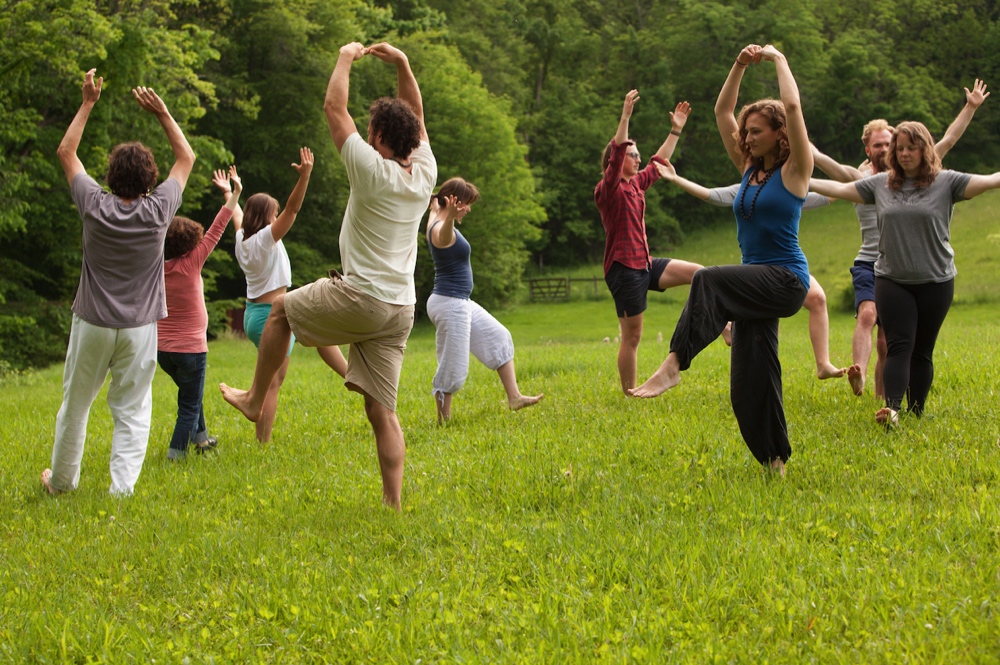
Breema: The Art of Being Present
By David Pratt and Laura Ike, Certified Breema Instructors
*A shorter version of this article appeared in the June, 2015 issue of Natural Awakenings, Columbus.
John is sitting on the floor between his partner’s feet, and she is lying comfortably on her back. Before contacting her, he registers his breath for one inhalation and one exhalation. When he brings his relaxed palms to rest on her insteps, he lets his hands mold to the shape of her feet. Slowly and naturally, he lets his weight shift to the right as he exhales, back to center on inhalation, to the left on exhalation, and so on. At some point, he notices that he has gotten involved in thoughts. Without hurry or judgment, he asks his mind to experience his breath and continues moving in a way that is most comfortable for his body. Instead of mentally programming how far each lean will go, he allows the body to do what is most comfortable, which creates relaxed attention to just being with the leaning. As his mind stays with the activity of the body, the experience takes on an effortless quality. The pressure of time drops away, and John tastes a new energy that comes from more fully participating in life.
Breema is a holistic Teaching, and it includes three key elements: the Nine Principles of Harmony, Breema partner bodywork and Self-Breema exercises. The bodywork and Self-Breema exercises serve as tremendous supports for experiencing the Essential, unconditioned self. Both have a natural beauty and vitalizing atmosphere that can even have a harmonizing effect on observers. This is so because of Breema’s universal principles, which students use as a simple guide to becoming present. What students learn
firsthand is that that this practical approach can help bring them to a simple but tangible taste—an actual experience—of their own existence. Gradually, there is greater clarity between what is conditioned in them and a dimension of Consciousness that supports seeing that they are not their thoughts, feelings or sensations.
When students come to Breema classes, they quickly see that the mind, feelings and body are often not working together. The mind wanders, the feelings react, and much of the time, they are not connected to the physical body. As a class progresses, students find out what happens when they work with the Breema principles.
One of the first principles is Body Comfortable. This is so simple. With the partner work, before even contacting the other person’s body, students check in to see if their own bodies are comfortable. As the exchange unfolds (and the treatment sequences are diverse, with gentle leans, nurturing brushes and playful rocking movements) this principle of Body Comfortable serves as a guide in the direction of being present. For example, as a student raises her partner’s arm, she keeps including her own body and experience. This serves as a way for her to return the mind to the activity of the body and to stay with it a little longer.
The aim is no different when practicing Self-Breema exercises, which are done with one's own body. These are vitalizing and balancing, using energizing tapping movements, firm-yet-gentle holds and unique postures, all of which help a student become more familiar with Presence.
Perhaps the mind has wandered. No big deal. Students are taught that they can simply come back to registering their breathing and resume working with Body Comfortable or another principle, like No Force or No Judgment. No Judgment is needed because there isn’t an aim to make the mind become different. In this way, the mind functions more and more like a supportive tool, instead of an errant wanderer, and gradually all of life becomes a field for becoming present.
After class, John is walking towards his car. As he reaches into his pocket to get his keys, he sees that he is lost in thought, not present. With his hand still in his pocket, he registers the movement of his body walking and slides his keys out with a wish to experience this moment. As he arrives at the car and brings the key to the lock, there is a taste of full participation and contentment that is no different than if he were doing a Self-Breema exercise. With gratitude, he sees that in this everyday activity he is nourished and revived in a way that he did not know before practicing Breema.
Dave Pratt and Laura Ike are certified Breema Instructors with many years of practice—Laura in Georgia and Dave in Ohio. Dave is co-owner of True Nature Holistic Retreats in Millersburg, Ohio where he teaches and gives treatments. Both Dave and Laura teach within their home states and beyond, sometimes getting together to have fun co-instructing.